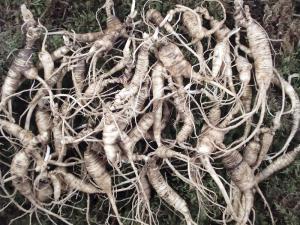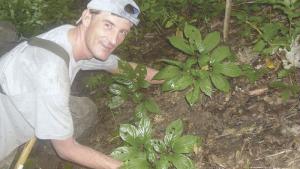2010 - Volume #34, Issue #6, Page #06
[ Sample Stories From This Issue | List of All Stories In This Issue | Print this story
| Read this issue]
Ginseng: You Can Hunt It Or Grow It
 |
 |
The fleshy, rooted herb is highly prized by Asian cultures as an aphrodisiac and a cure for many health conditions, and it's growing in popularity in the U.S. Ginseng grows primarily in China, Korea and parts of North America east of the Mississippi. Canada has banned digging wild ginseng, and the herb has become more difficult to find in China. In the U.S., digging wild ginseng is regulated. The Appalachian Mountains region is a popular hunting spot, though the herb can be found from Maine to Georgia.
Ginseng can be grown from seed in wooded areas or in open fields if structures are set up to provide shade.
WildGrown.com is a good place to start for anyone interested in harvesting or cultivating ginseng. The website includes regulations for 19 states, dealers who buy the roots, companies that sell seeds and plants, and general information about ginseng and production. WildGrown also buys ginseng.
"We want to provide as much info as possible for people who dig and want to grow ginseng," says Michael Lee, manager. "It helps people so they get the right price. They can find dealers and call around."
For those who want to dig ginseng, he emphasizes the importance of knowing state regulations which include the seasons it can be dug (late summer to fall); deadlines for it to be sold, which is often the end of March; and even good stewardship tips, like the seeds in the berries of the ginseng should be planted wherever ginseng is dug.
Value of wild ginseng is determined by the age and shape. Long fingerlike roots are less valuable than bowl-shaped ginseng. Prices fluctuate every year from $300 to $1,000 per lb. for dried ginseng (about 3 lbs. of fresh ginseng makes 1 lb. dried ginseng). There's also a market for green ginseng, which people from Korea prefer.
The plants thrive in 70 to 80 percent shade and go dormant when conditions aren't ideal. Hunters often find ginseng 5-25 years after timber has been cut in an area. But it's found in many other locations as well. It takes about 10 years for the roots to be ready to harvest.
Hunting or growing ginseng is a passion for many. Lee notes that one of his sellers is 72 and has been digging roots since he was 10. With a strong export market to China and a growing market in the U.S., the demand for ginseng continues to be promising.
Contact: FARM SHOW Followup, WildGrown.com/National Ginseng, LLC., P.O. Box 103, Montgomery, Penn. 18936 (ph 888 675-7264; www.wildgrown.com).

Click here to download page story appeared in.

Click here to read entire issue
To read the rest of this story, download this issue below or click here to register with your account number.




